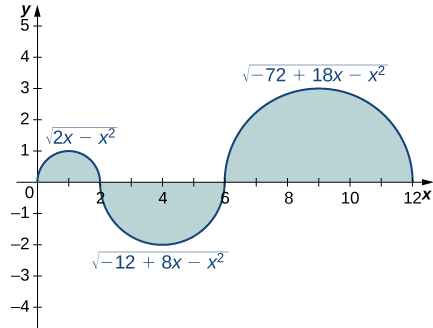5.5: Definite Integral Intro Exercises
- Last updated
- Jan 17, 2020
- Save as PDF
- Page ID
- 32816
( \newcommand{\kernel}{\mathrm{null}\,}\)
T
5.2: The Definite Integral
In the following exercises, express the limits as integrals.
60) limn→∞n∑i=1(x∗i)Δx over [1,3]
61) limn→∞n∑i=1(5(x∗i)2−3(x∗i)3)Δx over [0,2]
- Answer:
- ∫20(5x2−3x3)dx
62) limn→∞n∑i=1sin2(2πx∗i)Δx over [0,1]
63) limn→∞n∑i=1cos2(2πx∗i)Δx over [0,1]
- Answer:
- ∫10cos2(2πx)dx
In the following exercises, given Ln or Rn as indicated, express their limits as n→∞ as definite integrals, identifying the correct intervals.
64) Ln=1nn∑i=1i−1n
65) Rn=1nn∑i=1in
- Answer:
- fave=4528
Solution: ∫10xdx
66) Ln=2nn∑i=1(1+2i−1n)
67) Rn=3nn∑i=1(3+3in)
Solution: ∫63xdx
68) Ln=2πnn∑i=12πi−1ncos(2πi−1n)
69 Rn=1nn∑i=1(1+in)log((1+in)2)
Solution: ∫21xlog(x2)dx
In the following exercises, evaluate the integrals of the functions graphed using the formulas for areas of triangles and circles, and subtracting the areas below the x-axis.
70)
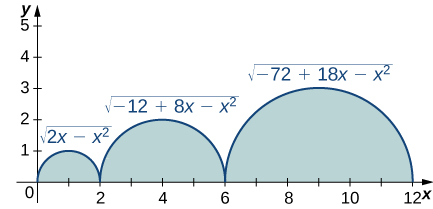
71)
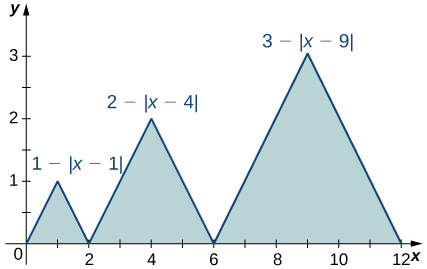
Solution: 1+2⋅2+3⋅3=14
72)
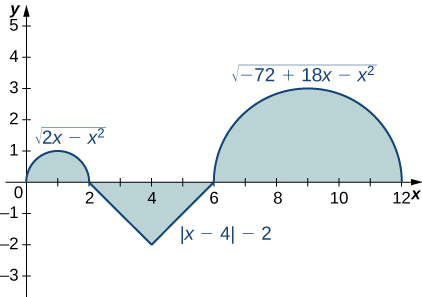
73)
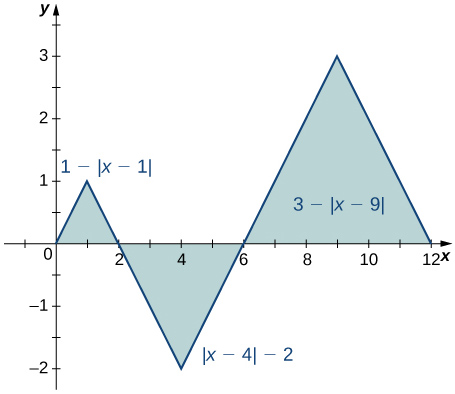
Solution: 1−4+9=6
74)
75)
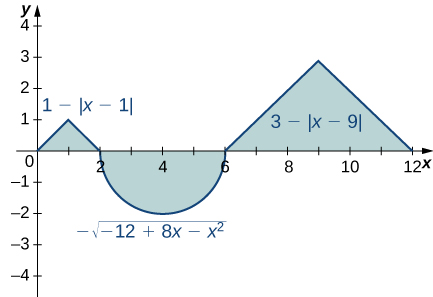
Solution: 1−2π+9=10−2π
In the following exercises, evaluate the integral using area formulas.
76) ∫30(3−x)dx
77) ∫32(3−x)dx
- Answer:
- The integral is the area of the triangle, 12
78) ∫3−3(3−|x|)dx
79) ∫60(3−|x−3|)dx
Solution: The integral is the area of the triangle, 9.
80) ∫2−2√4−x2dx
81) ∫51√4−(x−3)2dx
Soluti0n: The integral is the area 12πr2=2π.
82) ∫120√36−(x−6)2dx
83) ∫3−2(3−|x|)dx
Solution: The integral is the area of the “big” triangle less the “missing” triangle, 9−12.
In the following exercises, use averages of values at the left (L) and right (R) endpoints to compute the integrals of the piecewise linear functions with graphs that pass through the given list of points over the indicated intervals.
84) (0,0),(2,1),(4,3),(5,0),(6,0),(8,3) over [0,8]
85) (0,2),(1,0),(3,5),(5,5),(6,2),(8,0) over [0,8]
Solution: L=2+0+10+5+4=21,R=0+10+10+2+0=22,L+R2=21.5
86) (−4,−4),(−2,0),(0,−2),(3,3),(4,3) over [−4,4]
87) (−4,0),(−2,2),(0,0),(1,2),(3,2),(4,0) over [−4,4]
Solution: L=0+4+0+4+2=10,R=4+0+2+4+0=10,L+R2=10
Suppose that ∫40f(x)dx=5 and ∫20f(x)dx=−3, and ∫40g(x)dx=−1 and ∫20g(x)dx=2. In the following exercises, compute the integrals.
88) ∫40(f(x)+g(x))dx
89) ∫42(f(x)+g(x))dx
- Answer:
- ∫42f(x)dx+∫42g(x)dx=8−3=5
90) ∫20(f(x)−g(x))dx
91) ∫42(f(x)−g(x))dx
- Answer:
- ∫42f(x)dx−∫42g(x)dx=8+3=11
92) ∫20(3f(x)−4g(x))dx
93) ∫42(4f(x)−3g(x))dx
- Answer:
- 4∫42f(x)dx−3∫42g(x)dx=32+9=41
In the following exercises, use the identity ∫A−Af(x)dx=∫0−Af(x)dx+∫A0f(x)dx to compute the integrals.
94) ∫π−πsint1+t2dt (Hint: sin(−t)=−sin(t))
95) ∫√π√−πt1+costdt
Solution: The integrand is odd; the integral is zero.
96) ∫31(2−x)dx (Hint: Look at the graph of f.)
97) ∫42(x−3)3dx (Hint: Look at the graph of f.)
Solution: The integrand is antisymmetric with respect to x=3. The integral is zero.
In the following exercises, given that ∫10xdx=12,∫10x2dx=13, and ∫10x3dx=14, compute the integrals.
98) ∫10(1+x+x2+x3)dx
99) ∫10(1−x+x2−x3)dx
- Answer:
- 1−12+13−14=712
100) ∫10(1−x)2dx
101) ∫10(1−2x)3dx
Solution: ∫10(1−2x+4x2−8x3)dx=1−1+43−2=−23
102) ∫10(6x−43x2)dx
103) ∫10(7−5x3)dx
Solution: 7−54=234
In the following exercises, use the comparison theorem.
104) Show that ∫30(x2−6x+9)dx≥0.
105) Show that ∫3−2(x−3)(x+2)dx≤0.
Solution: The integrand is negative over [−2,3].
106) Show that ∫10√1+x3dx≤∫10√1+x2dx.
107) Show that ∫21√1+xdx≤∫21√1+x2dx.
Solution: x≤x2 over [1,2], so √1+x≤√1+x2 over [1,2].
108) Show that ∫π/20sintdt≥π4) (Hint: sint≥2tπ over [0,π2])
109) Show that ∫π/4−π/4costdt≥π√2/4.
Solution: cos(t)≥√22. Multiply by the length of the interval to get the inequality.
In the following exercises, approximate the average value using Riemann sums L100 and R100. How does your answer compare with the exact given answer?
116) [T] y=ln(x) over the interval [1,4]; the exact solution is ln(256)3−1.
117) [T] y=ex/2 over the interval [0,1]; the exact solution is 2(√e−1).
5olution: L100=1.294,R100=1.301; the exact average is between these values.
118) [T] y=tanx over the interval [0,π4]; the exact solution is 2ln(2)π.
119) [T] y=x+1√4−x2 over the interval [−1,1]; the exact solution is π6.
Solution: L100×(12)=0.5178,R100×(12)=0.5294
In the following exercises, compute the average value using the left Riemann sums LN for N=1,10,100. How does the accuracy compare with the given exact value?
120) [T] y=x2−4 over the interval [0,2]; the exact solution is −83.
121) [T] y=xex2 over the interval [0,2]; the exact solution is 14(e4−1).
Solution: L1=0,L10×(12)=8.743493,L100×(12)=12.861728. The exact answer ≈26.799, so L100 is not accurate.
122) [T] y=(12)x over the interval [0,4]; the exact solution is 1564ln(2).
123) [T] y=xsin(x2) over the interval [−π,0]; the exact solution is cos(π2)−12π.
Solution: L1×(1π)=1.352,L10×(1π)=−0.1837,L100×(1π)=−0.2956. The exact answer ≈−0.303, so L100 is not accurate to first decimal.
124) Suppose that A=∫2π0sin2tdt and B=∫2π0cos2tdt. Show that A+B=2π and A=B.
125) Suppose that A=∫π/4−π/4sec2tdt=π and B=∫π/4−π/4tan2tdt. Show that A−B=π2.
Solution: Use tan2θ+1=sec2θ. Then, B−A=∫π/4−π/41dx=π2.
126) Show that the average value of sin2t over [0,2π] is equal to 1/2 Without further calculation, determine whether the average value of sin2t over [0,π] is also equal to 1/2.
127) Show that the average value of cos2t over [0,2π] is equal to 1/2. Without further calculation, determine whether the average value of cos2(t) over [0,π] is also equal to 1/2.
Solution: ∫2π0cos2tdt=π, so divide by the length 2π of the interval. cos2t has period π, so yes, it is true.
128) Explain why the graphs of a quadratic function (parabola) p(x) and a linear function ℓ(x) can intersect in at most two points. Suppose that p(a)=ℓ(a) and p(b)=ℓ(b), and that ∫bap(t)dt>∫baℓ(t)dt. Explain why ∫dcp(t)>∫dcℓ(t)dt whenever a≤c<d≤b.
129) Suppose that parabola p(x)=ax2+bx+c opens downward (a<0) and has a vertex of \displaystyle y=\frac{−b}{2a}>0. For which interval \displaystyle [A,B] is \displaystyle ∫^B_A(ax^2+bx+c)dx as large as possible?
Solution: The integral is maximized when one uses the largest interval on which p is nonnegative. Thus, \displaystyle A=\frac{−b−\sqrt{b^2−4ac}}{2a} and \displaystyle B=\frac{−b+\sqrt{b^2−4ac}}{2a}.
130) Suppose \displaystyle [a,b] can be subdivided into subintervals \displaystyle a=a_0<a_1<a_2<⋯<a_N=b such that either \displaystyle f≥0 over \displaystyle [a_{i−1},a_i] or \displaystyle f≤0 over \displaystyle [a_{i−1},a_i]. Set \displaystyle A_i=∫^{a_i}_{a_{i−1}}f(t)dt.
a. Explain why \displaystyle ∫^b_af(t)dt=A_1+A_2+⋯+A_N.
b. Then, explain why \displaystyle ∫^b_af(t)dt∣∣∣≤∫^b_a|f(t)|dt.
131) Suppose \displaystyle f and \displaystyle g are continuous functions such that \displaystyle ∫^d_cf(t)dt≤∫^d_cg(t)dt for every subinterval \displaystyle [c,d] of \displaystyle [a,b]. Explain why \displaystyle f(x)≤g(x) for all values of x.
Solution: If \displaystyle f(t_0)>g(t_0) for some \displaystyle t_0∈[a,b], then since \displaystyle f−g is continuous, there is an interval containing \displaystyle t_0 such that \displaystyle f(t)>g(t) over the interval \displaystyle [c,d], and then \displaystyle ∫^d_df(t)dt>∫^d_cg(t)dover this interval.
132) Suppose the average value of \displaystyle f over \displaystyle [a,b] is 1 and the average value of f over [b,c] is 1 where \displaystyle a<c<b. Show that the average value of \displaystyle f over \displaystyle [a,c] is also 1.
133) Suppose that \displaystyle [a,b] can be partitioned. taking \displaystyle a=a_0<a_1<⋯<a_N=b such that the average value of \displaystyle f over each subinterval \displaystyle [a_{i−1},a_i]=1 is equal to 1 for each \displaystyle i=1,…,N. Explain why the average value of f over \displaystyle [a,b] is also equal to 1.
Solution: The integral of f over an interval is the same as the integral of the average of f over that interval. Thus, \displaystyle ∫^b_af(t)dt=∫^{a_1}_{a_0}f(t)dt+∫^{a_2}_a{1_f}(t)dt+⋯+∫^{a_N}_{a_{N+1}}f(t)dt=∫^{a_1}_{a_0}1dt+∫^{a_2}_{a_1}1dt+⋯+∫^{a_N}_{a_{N+1}}1dt
\displaystyle =(a_1−a_0)+(a_2−a_1)+⋯+(a_N−a_{N−1})=a_N−a_0=b−a.
Dividing through by \displaystyle b−a gives the desired identity.
134) Suppose that for each i such that \displaystyle 1≤i≤N one has \displaystyle ∫^i_{i−1}f(t)dt=i. Show that \displaystyle ∫^N_0f(t)dt=\frac{N(N+1)}{2}.
135) Suppose that for each i such that \displaystyle 1≤i≤N one has \displaystyle ∫^i_{i−1}f(t)dt=i^2. Show that \displaystyle ∫^N_0f(t)dt=\frac{N(N+1)(2N+1)}{6}.
Solution: \displaystyle ∫^N_0f(t)dt=\sum_{i=1}^N∫^i_{i−1}f(t)dt=\sum_{i=1}^Ni^2=\frac{N(N+1)(2N+1)}{6}
136) [T] Compute the left and right Riemann sums \displaystyle L_{10} and \displaystyle R_{10} and their average \displaystyle \frac{L_{10}+R_{10}}{2} for \displaystyle f(t)=t^2over \displaystyle [0,1]. Given that \displaystyle ∫^1_0t^2dt=1/3, to how many decimal places is \displaystyle \frac{L_{10}+R_{10}}{2} accurate?
137) [T] Compute the left and right Riemann sums, \displaystyle L_10 and \displaystyle R_{10}, and their average \displaystyle \frac{L_{10}+R_{10}}{2} for \displaystyle f(t)=(4−t^2) over \displaystyle [1,2]. Given that \displaystyle ∫^2_1(4−t^2)dt=1.66, to how many decimal places is \displaystyle \frac{L_{10}+R_{10}}{2} accurate?
Solution: \displaystyle L_{10}=1.815,R_{10}=1.515,\frac{L_{10}+R_{10}}{2}=1.665, so the estimate is accurate to two decimal places.
138) If \displaystyle ∫^5_1\sqrt{1+t^4}dt=41.7133..., what is \displaystyle ∫^5_1\sqrt{1+u^4}du?
139) Estimate \displaystyle ∫^1_0tdt using the left and right endpoint sums, each with a single rectangle. How does the average of these left and right endpoint sums compare with the actual value \displaystyle ∫^1_0tdt?
Solution: The average is \displaystyle 1/2, which is equal to the integral in this case.
140) Estimate \displaystyle ∫^1_0tdt by comparison with the area of a single rectangle with height equal to the value of t at the midpoint \displaystyle t=\frac{1}{2}. How does this midpoint estimate compare with the actual value \displaystyle ∫^1_0tdt?
141) From the graph of \displaystyle sin(2πx) shown:
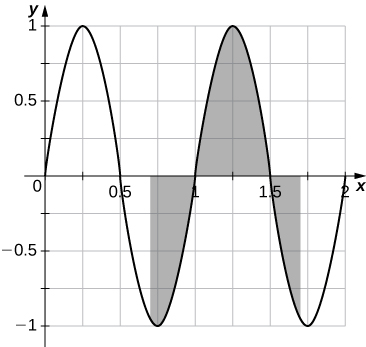
a. Explain why \displaystyle ∫^1_0sin(2πt)dt=0.
b. Explain why, in general, \displaystyle ∫^{a+1}_asin(2πt)dt=0 for any value of a.
- Answer:
-
a. The graph is antisymmetric with respect to \displaystyle t=\frac{1}{2} over \displaystyle [0,1], so the average value is zero.
b. For any value of a, the graph between \displaystyle [a,a+1] is a shift of the graph over \displaystyle [0,1], so the net areas above and below the axis do not change and the average remains zero.
142) If f is 1-periodic \displaystyle (f(t+1)=f(t)), odd, and integrable over \displaystyle [0,1], is it always true that \displaystyle ∫^1_0f(t)dt=0?
143) If f is 1-periodic and \displaystyle ∫10f(t)dt=A, is it necessarily true that \displaystyle ∫^{1+a}_af(t)dt=A for all A?
Solution: Yes, the integral over any interval of length 1 is the same.
J5.2.1) not here yet


